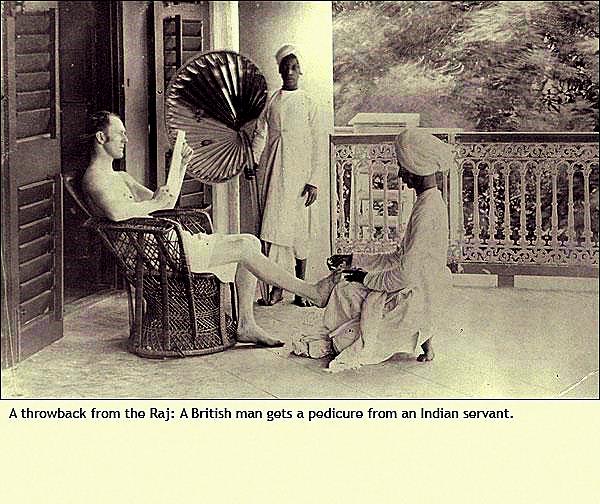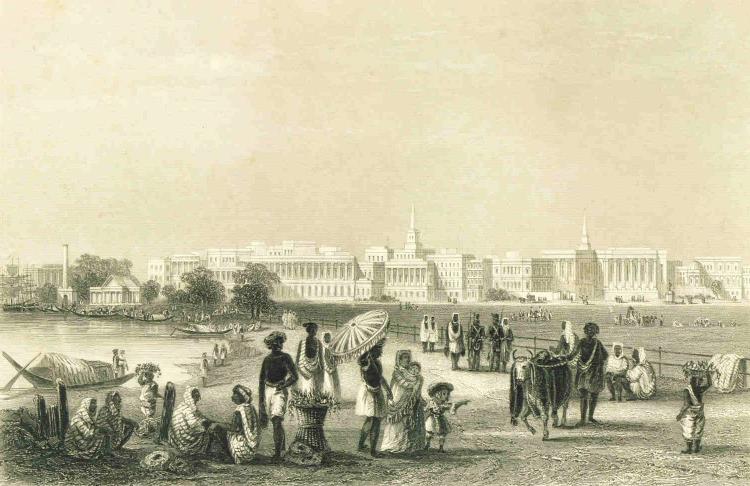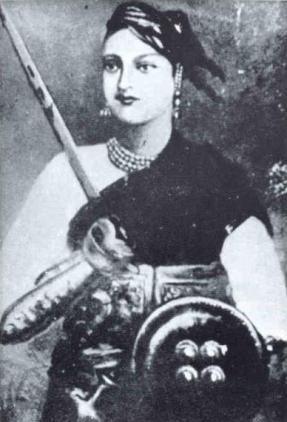A British man gets a pedicure from an Indian servant

Topics on the Page
Summary
The economic and political relationship between India and Britain
- The Sepoy Rebellion
- Lakshmi Bai
CROSS-LINK: Dramatic Event Page: The British Raj in India
The building of roads, canals, railroads, and universities
The rise of Indian nationalism and nonviolence under Gandhi's influence
CROSS-LINK: Mohandas Gandhi, Indian Independence Leader
![]() CROSS-LINKS
CROSS-LINKS
AP World History Key Concept 6.2
19th Century European Imperialism
Imperialism in China in the 19th and early 20th Century
Imperialism in Japan in the 19th and early 20th Century
Focus Question: What are some major developments in Indian history in the 19th and early 20th century?
Summary
Antique steel engraving of Calcutta in the Bengal Presidency of British India, 1840

In the beginning of the 19th century, India was a colony controlled by the British East India Company, which used India's strategic geography to expand British power and wealth through trade.
- The British invested greatly in infrastructure such as roads and railroads in order to improve commerce and military power and implemented an education system based on the English language and Western thought. Over time, many Indians became resentful of their colonizers.
- Classism developed between British colonizers and India's natives, as colonizers assumed their British background made them more civilized than the locals. The British would often justify poor treatment of locals by insisting their presence in India was beneficial for the nation's progress. though often they exploited natives for labor.
- The Sepoy Rebellion, an act of mutiny against British soldiers in India, is often considered the beginning of the independence movement. After this rebellion, the British crown dismantled the British East India Company and took control of the continent, a period known as the British Raj.
- The movement toward independence gained momentum with Mohandas Gandhi, who encouraged civil disobedience through non-violent methods. As Gandhi's ideas spread, Britain's power waned.
- After hard losses from World War II and with tensions between Indian Muslims and Hindus increasing, the British granted independence, partitioning the subcontinent into the Union of India and the Dominion of Pakistan in 1947.
India and Britain's Relations

Flag of the British East India Trading Company 1801-1858
In the 19th century, Britain saw India as its most important colony.
- The British East India Company was established in order to create trade routes to the East Indies and expanded to rule most of the Indian subcontinent; tensions arose between the Indian populace and the company starting in the mid-18th century.
- The Battle of Plassey (video) was the East India Company's first victory on Indian soil after the Nawab of Bengal was defeated by Robert Clive.
- The company profited from a strategic position in the cotton, silk, indigo dye, tea, and illegal opium trades.
British Imperialism in India Timeline
British Attitudes towards Indians lesson plan by PBS
Youtube Video - Current Indian Politician Shashi Tharoor argues why British colonialism destroyed India
The Sepoy Rebellion

In 1857, Indian soldiers who worked for the Company (Sepoys) became disillusioned with a government which did not represent their interests.
- This is known as the Sepoy Rebellion, the Indian Rebellion or the First War of Independence. The rebellion failed, the British troops reestablished control. Fearing another mutiny, the Company was dissolved, and India came under direct rule of the British crown.
![]()
Video that explains Sepoy Rebellion and its effects
Another video about the Sepoy Rebellion
![]() A collection of primary sources from Fordham University, covering British rule, the Sepoy Rebellion, Indian nationalism, and independence.
A collection of primary sources from Fordham University, covering British rule, the Sepoy Rebellion, Indian nationalism, and independence.
The British Raj
The new colonial government that ruled until Indian independence in 1947 is called the British Raj .
- Under rule of the British Raj, the Indian people saw their customs and history being pushed aside in favor of British customs.
- Like most colonized people, Indians wanted a say in how their nation was ruled and yet did not receive much support from their colonizers.
- The British pushed their ideas of law and order on the Indian people, creating conflict with and undermining the existing Indian government. Although the British ostensibly tried to incorporate natives into the lawmaking process and let them have some sort of governmental role, Indian influence was hardly seen or felt.
- Britain ruled the area with their interests in mind and made many political moves without the consent of Indian people, including entering India into both World Wars.
- A major problem to come out of this period was the destruction of India’s economic and political systems. The British did everything to their own advantage, including preventing economic growth for India and dismantling any sort of political power.
- Because of this, post-independence India became one of the poorest nations in the world and had a political system that needed to be reshaped.
- The economy was left far behind that of any other nation, a contrast to their strong precolonial economy. India suffered dramatically and is still facing the many problems colonization had on its economy and society, including low life expectancy rates and high famine frequency.
![]() Learning Plans
Learning Plans
Here is a PBS lesson plan on the 19th century British Raj
BBC page about the British Raj (1858-1947)
Photo collection of life during the British Raj
Portrait of Lakshmi Bai, the Ranee of Jhansi, (c. 1850s)

![]() Lakshmi Bai, the Rani of the state of Jhansi in India, was a leader of the Indian nationalist movement.
Lakshmi Bai, the Rani of the state of Jhansi in India, was a leader of the Indian nationalist movement.
Short video on Lakshmi Bai
After being widowed without producing a male heir, the British threatened to annex Jhansi. Rani Lakshmiba assembled an army of volunteers and fought for control of her land.
She died in battle, but became a symbol of nationalism, bravery, and women's empowerment.
For more information on women and the British Raj:
Servitude Through Symbolism: Women and Power Struggles in the British Raj
Indian Women in the 19th and 20th century
B. Roads, Canals, Railroads and Universities
4 transport systems developed in India under British Rule
| Marquess of Dalhousie, James Broun-Ramsay |
The legacy of economic development of India while under British rule is controversial.
- The British undertook a number of infrastructure projects in order to improve India and promote commerce within, but also to exploit resources.
- As with many developments in India, the creation of roads, canals, and railroads were done to improve the British situation and give them a military advantage.
- Despite this fact, Britain's structural improvements to India during the colonial period are generally considered a positive effect. These transportation lines also were important in the spread of ideas among India's population.
But What About the Railways? The Myth of Britain's Gifts to India
Trams of British India

Most of the work on creating the railway, road and canal systems was done during the rule of James Broun-Ramsay, 1848-1856 [6].
- Ramsay was the head of the British Raj at the time, in the position of Governor-General.
- Broun-Ramsay's policies allowed for much improvement, although some historians believe he was responsible for the Sepoy Rebellion and the eventual breakdown of the British East India Company.
- By the early 20th century, India had the fourth-largest railway system in the world.
Click here for a map of India's railways in 1909.
Prior to colonization, India already had a well-established university system that offered a different approach to education than the British system.
- The British promoted English-language schools which taught Western science and thought.
- By teaching the English language, the British hoped to create a population loyal to the British Empire and able to work low-wage jobs.
- Though with intentions of exploitation, British investment in Indian education allowed wealthier Indians to develop knowledge of democracy, economics, and nationalism, as well as to travel to London for study (as Gandhi did).
A number of missionaries' wives like Martha Mault and Eliza Caldwell fought to educate Indian girls. They met much resistance from Indian people since they were trying to change the status quo.
Activities and lessons on the impact of British economics in India
An 1871 assessment of British Rule
An essay centering on colonial rule and racism in India.
F. Muslims in the 19th century India
At the start of the 19th century, British viceroy Lord Curzon partitioned the province of Bengal. This inadvertently set into motion the modern Hindu-Muslim tensions in India. Protests irrupt it amongst the Bangladesh is Hindu elite, who also happens to be the minority in the area. They were going to potentially lose a large portion of their income, which was rent gather from the Muslim majority. Hindu nationalists started to act violently towards the Muslim people in the name of their Hindu brothers. India’s Muslim elite formed the All-India Muslim League in 1906 in retaliation. It was this organization that was the largest proponent for Muslim rights and became the most prominent supporter for the creation of Muslim Pakistan.
Muslims had always been the largest religious minority in India. During the 1930s, when Mahatma Gandhi was attempting to free India from British colonization, the Muslim population did not want to be ruled by a Hindu majority. They fought for an independent Muslim state. This tension came to ahead after World War II. In 1947, Britain met with the Hindu Congress party in the Muslim league to negotiate the countries independence. At this point, tensions were so high between the two groups that even Britain supported dividing the area into two independent states. In August 1947, Pakistan is born. Originally, Pakistan was divided into a western and eastern part, with India proper separating the two. Violence irrupted along the borders of these two newly formed countries because of the tension between the two groups, the ill-defined British borders, and the mass migration of people attempting to find safety.
Read here for more information on Muslims in India at the start of the 19th century
Watch the first 3:33 minutes of this video for the whole history of this subject
Watch this video to understand Britain's part in the partition of Pakistan and India
Links
[1] Lay, V. (February 7, 2007). British India. Retrieved March 3, 2007, from Manas: India and its Neighbors Web site: http://www.sscnet.ucla.edu/southasia/index.html
[2] Patel, N. (1998). The Sepoy War of 1857 Mutiny or First Indian War of Independence?. Retrieved March 3, 2007, from Post Colonial Studies at Emory Web site: http://www.english.emory.edu/Bahri/Mutiny.html
[3] Lay, V. (February 7, 2007). The East India Company. Retrieved March 3, 2007, from Manas: India and its Neighbors Web site: http://www.sscnet.ucla.edu/southasia/History/British/EAco.html
[4] (February 13, 2007). Mahatma Gandhi. Retrieved March 3, 2007, from Welcome to the complete site on Mahatma Gandhi Web site: http://www.mkgandhi.org/
[5] McGeary, Johanna. 27 Dec 1999. "Mohandas Gandhi." Time Magazine. http://www.cnn.com/ALLPOLITICS/time/1999/12/27/gandhi.html. Retrieved March 2, 2013.
[6] James Andrew Broun Ramsay. Retrieved March 3, 2007, from Encyclopedia Britannica Online Web site: http://www.britannica.com/eb/article-9362193/James-Andrew-Broun-Ramsay-marquess-of-Dalhousie